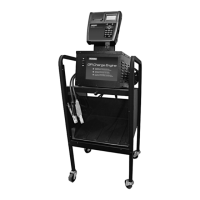5:/057
0LWL,06WWL,
LWL
7.4 Turn OFF all vehicle loads, including door lights, and cor-
rect any defects in the vehicle’s electrical system that may
have caused low battery.
7.5 Check the polarity of the battery posts. The POSITIVE
(POS., P, +) post usually has a larger diameter than the
NEGATIVE (NEG., N,–) post.
7.6 Determine which post of the battery is grounded (connect-
ed) to the chassis. If the negative post is grounded (as in most
vehicles), see paragraph 7.7. If the positive post is grounded,
see paragraph 7.8.
7.7 For a negative-grounded vehicle, rst connect the POSI-
TIVE (RED) clamp from the charger to the POSITIVE (POS.,
P, +) ungrounded post of the battery. Then connect the
NEGATIVE (BLACK) clamp to the vehicle chassis or engine
block away from the battery. Do not connect the clamp to
the carburetor, fuel lines, or sheet-metal body parts. Con-
nect to a heavy-gauge metal part of the frame or engine
block. When disconnecting the charger, turn all switches
to OFF, disconnect the AC cord, remove the clamp from
the vehicle chassis, and then remove the clamp from the
battery terminal.
7.8 For positive-grounded vehicle, connect the NEGATIVE
(BLACK) clamp from the charger to the NEGATIVE (NEG.,
N, –) ungrounded post of battery. Then connect the POSI-
TIVE (RED) clamp to the vehicle chassis or engine block
away from the battery. Do not connect clamp to carbu-
retor, fuel lines, or sheet-metal body parts. Connect to a
heavy gauge metal part of frame or engine block.
When disconnecting the charger, turn the switches to
OFF, disconnect the AC cord, remove the clamp from
the vehicle chassis, and then remove the clamp from the
battery terminal.
CAUTION: WHEN POSITIVE (+) POST OF VEHICLE
BATTERY IS GROUNDED, DOUBLE CHECK POLARITY.
8. FOLLOW THESE STEPS WHEN THE BATTERY IS INSTALLED
IS OUTSIDE OF THE VEHICLE. A SPARK NEAR THE BATTERY
MAY CAUSE A BATTERY EXPLOSION. TO REDUCE THE RISK
OF A SPARK NEAR THE BATTERY:
If it is necessary to remove the battery from the vehicle or
equipment, always remove the grounded terminal from
the battery rst.
WARNING: Make sure all vehicle loads are OFF to prevent a
possible arc.
8.1 Check the polarity of battery posts. POSITIVE (POS., P, +)
post usually has larger diameter than NEGATIVE (NEG., N,
–) post.
8.2 Attach at least a 60 cm (24-inch), 6-gauge insulated battery
cable to the negative (–) battery terminal.
8.3 Connect the POSITIVE (RED) charger clamp to the POSI-
TIVE (POS., P, +) post of battery.
8.4 Position yourself and the free end of cable as far away from
the battery as possible—do not face the battery when
making the nal connection—then connect the NEGA-
TIVE (BLACK) charger clamp to the free end of the cable.
8.5 When disconnecting the charger, always do so in the re-
verse sequence of the connecting procedure; break the
rst connection while staying as far away from the battery
as practical.
8.6 MARINE “BOAT” BATTERIES MUST BE REMOVED AND
CHARGED ON SHORE. TO SAFELY CHARGE THEM ON
BOARD REQUIRES EQUIPMENT ESPECIALLY DESIGNED
FOR MARINE USE.
6DIHW,VWUXFWLRV

